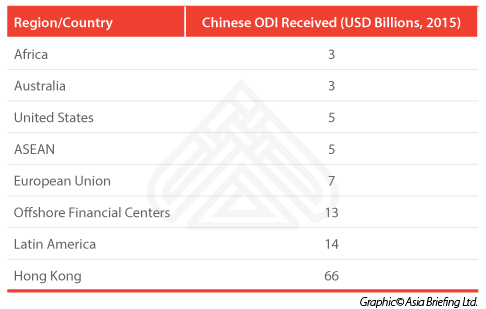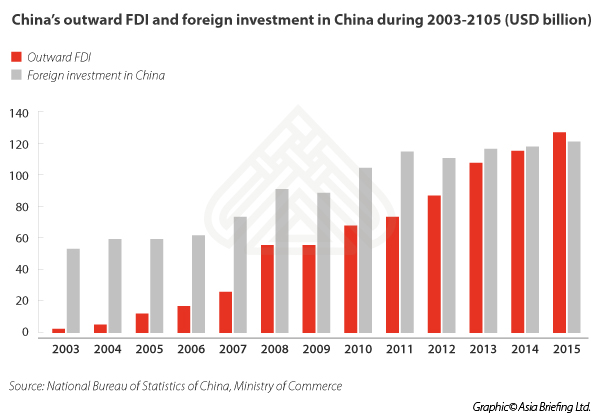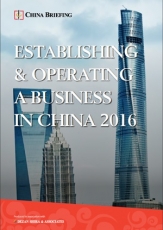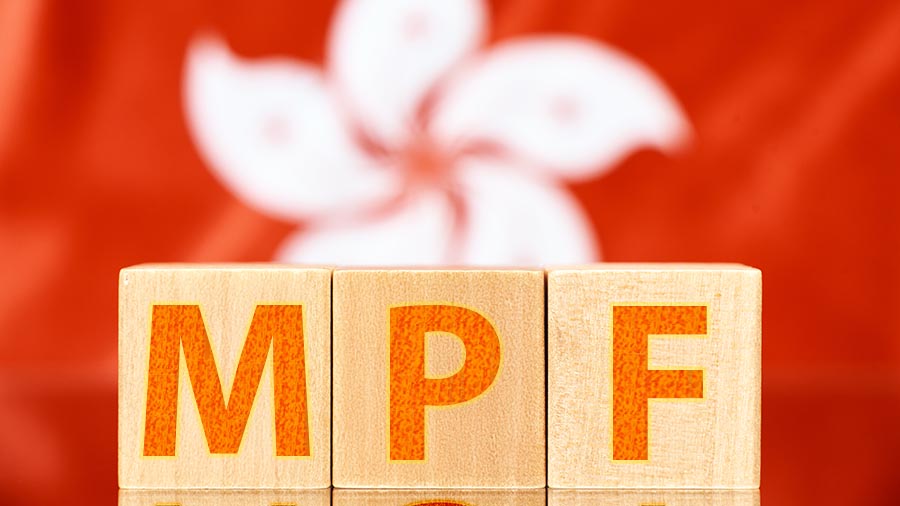Chasing China’s Outbound Direct Investment
Chinese outbound direct investment (ODI) is becoming a hot topic as politicians seek to attract Chinese money and investment into their countries, hoping to spur employment and create jobs. In particular, banks, law firms, advisors and auditors are all chasing Chinese ODI, with many firms positioning themselves to list Chinese companies on capital markets and possibly generate substantial fees. Yet the realities of Chinese ODI flows is not as openly depicted in the Western media or even on Wall Street.
According to China’s National Statistics Bureau, in 2015, total ODI was US$207 billion in terms of contractual value, with US$118 billion being actualized. Hong Kong received the most Chinese ODI, with Latin America a distant second, with offshore financial centers closely following. The EU and the U.S. fall fourth and sixth on the list, respectively.

Moreover, in 2015, Chinese ODI was greater than foreign investment in China for the first time.

There are some surprising elements to these figures, not least of which is the relatively small amount of ODI received by the U.S. – just four percent. By contrast, Latin America received US$14 billion – nearly three times as much. Although many will point to the huge amount being received by Hong Kong as “proof” that the U.S. is receiving Chinese investment dollars from repackaged offshore investment entities, such as BVI and Cayman’s incorporations, and while this may be partially true, there is a limit as to how much of this is actually destined for the U.S. Much will often be in the form of Chinese and foreign investment capital, packaged together with equity holdings determined in the Caymans or BVI or other similar offshore investment structures. The truth is, the value of the money being repackaged from Chinese ODI into Hong Kong and then departing Hong Kong cannot be verified. What is known, however, is that much of this will be “round-tripping” by mainland Chinese investors using Hong Kong as an investment base to obtain preferential tax treatments available under the China-Hong Kong CEPA agreement. Whatever the truth, the reality is that the U.S. is not a priority destination for Chinese ODI.
China is ruled by policy laid down by the Chinese Communist Party, and to understand where the money flows to, one needs to follow Chinese policy. It is quite clear in my view that China has a very well defined overseas direct investment policy, and that it is not geared towards the U.S. in any way. Instead, it is geared at securing commodities, food and energy resources, in addition to securing future trade routes. When taken in this context, China’s ODI into Latin America and Africa make more sense. The Africa picture was explained in my recent book, China’s New Economic Silk Road, where I identify China’s search for African oil in Angola, Sudan and the Democratic Republic of the Congo, as well as the development of the Trans-African Railway (paid for by China) in Kenya, Uganda, Burundi, Rwanda and South Sudan. The Nairobi-Mombassa route is currently being constructed and will be operational by 2018.
According to Kevin P. Gallagher, an Associate Professor of International Relations at Boston University and a Senior Researcher at the Global Development Institute at Tufts University, about 96.7 percent of ODI into Latin America is done via the Cayman Islands and BVI. This means that Hong Kong is indeed repackaging Chinese money into structures. This will often be with other foreign investors (including U.S.) as China looks to marry up its finance with more regional expertise. Both Africa and Latin America are receiving investment from China as it looks to secure energy and commodities, and the Chinese are quite prepared to build infrastructure to accommodate this. Teams of Chinese companies and engineers are currently building roads, rail ports and other infrastructure on a global scale. I highlighted this trend back in 2013 in the article, “China, the Great Infrastructure Developer”. The pace of this has only increased and intensified since then.
In terms of the bigger picture moving forward, it is quite clear that China is committed to its Silk Road project and to utilizing existing institutional structures it has already put in place. Of these, one of the most important is the Shanghai Co-Operation Organization (SCO), an entity that includes China, Russia, and India, as well as much of Central Asia as members. These three countries also make up the largest shareholders in the Asian Infrastructure Investment Bank (AIIB), a US$50 billion capitalized entity. China has also established a de facto BRICS bank, the New Development Bank, with the same three core members, with the addition of Brazil and South Africa, with US$50 billion. These moves provide a clear indication of China’s ODI policy – infrastructure investment into Eurasia and the securing of commodities in the region as well as in Latin America and Africa. The key to this is going to be infrastructure developments linking the continent together; bringing China, India and Russia together, as well as the neighboring countries in Central and South East Asia.
Europe will benefit to some extent as it is on the same land mass. It is also seen as a potential investment partner. Much of Western Europe is already wealthy and stands to gain from investing into the greater flow of trade and services that improved Eurasian infrastructure. China, as we have seen, is also building infrastructure in Latin and Central America. The recent Panama Canal upgrade was financed with Chinese money. In fact, if there is one country that is being specifically excluded from these developments, one may even suggest isolated, it is the U.S.
This pivot by China to developing Eurasia has additionally been underlined by the announcement last Friday by China’s Ministry of Commerce that proposes a Free Trade Area encompassing all the members of the SCO, a suggestion that Russia has suggested expanding to include the Eurasian Economic Union and ASEAN.
ASEAN overtook China in the amount of FDI it received back in 2013, and India’s GDP growth rate overtook that of China’s last year. This combination of huge markets, high growth rates and latent potential are proving more practical and politically attractive than Chinese money supporting American jobs and companies.
From these developments, which are being instigated and pushed forward as a matter of Chinese state policy and investment, it is clear where Chinese ODI flows will be heading. It also means that American hopes of Chinese investment entering the United States, investing in factories and creating new jobs is going to remain a pipe dream. Some will happen, but I cannot see much of an increase, if any, from the current level. Much of U.S.-bound ODI has been largely based on property acquisitions, which does not create jobs, and there is only so much American property that Chinese nationals will invest in. Chinese companies looking to sell to the U.S. may well seek listings, but these are unlikely to be as numerous as Wall Street imagines.
Tom Chang, CEO of the East-West Bank told me two days ago that China’s ODI was expected to rise to US$350 billion annually by 2025, making China the world’s second largest overseas investor. It is this figure that is exciting Wall Street. However, the reality is that China has already indicated where this money is to be directed, and the U.S. is not going to be a large recipient. Future trade and investment flows from Chinese ODI will instead be as follows:
- The China-India Trade Corridor
- The China-ASEAN Trade Corridor
- The China-Russia Trade Corridor
- The China-Central Asia Trade Corridor
- The China-Middle East Trade Corridor
- The China-Latin America Trade Corridor
- The China-Africa Trade Corridor
Businesses strategically positioning themselves in these areas will benefit. In my book, I questioned some of the rhetoric used by China and advised caution against hyperbole. I also identified potential problems as well as potential opportunities. Yet amongst the caution expressed, I suggested that indications as to China’s real ambitions and intentions for the development of Eurasia could be flagged, which would suggest that China is serious about the areas as a recipient of its ODI. A few key development markers were the following:
- Iran and India join the SCO;
- Russia and the Eurasian Economic Union commence tax reforms;
- China expands its DTA to include services;
- China and the Philippines “agree to disagree” over the South China Sea;
- India signs an FTA with the Eurasian Economic Union; and
- China signs an FTA with the Eurasian Economic Union.
Of these markers, twelve months on, the first four have all occurred while both China and India have commenced negotiations concerning an FTA with the Eurasian Economic Union. Other markers, such as the EU dropping sanctions against Russia, and China agreeing to a deal with the European Union, are yet to happen. However, I believe that the message is clear – China’s ODI is going into Eurasia, new trade corridors are beginning to emerge, and businesses globally need to adapt to the idea of Eurasia becoming a new investment and development hub, and position themselves accordingly.
|
Chris Devonshire-Ellis is the Chairman of Dezan Shira & Associates in Asia, and a consultant to Russia Consulting in Moscow. He is able to advise on all matters of Chinese expansion and development into Asia. Dezan Shira & Associates are a multi-disciplinary practice advising foreign investors throughout Asia, and have offices throughout China, Hong Kong, India, and ASEAN. Please contact the firm at asia@dezshira.com or visit www.dezshira.com. |

 China’s New Economic Silk Road: The Great Eurasian Game & The String of Pearls
China’s New Economic Silk Road: The Great Eurasian Game & The String of Pearls
This unique and currently only available study into the proposed Silk Road Economic Belt examines the institutional, financial and infrastructure projects that are currently underway and in the planning stage across the entire region. Covering over 60 countries, this book explores the regional reforms, potential problems, opportunities and longer term impact that the Silk Road will have upon Asia, Africa, the Middle East, Europe and the United States.
 Establishing & Operating a Business in China 2016
Establishing & Operating a Business in China 2016
Establishing & Operating a Business in China 2016, produced in collaboration with the experts at Dezan Shira & Associates, explores the establishment procedures and related considerations of the Representative Office (RO), and two types of Limited Liability Companies: the Wholly Foreign-owned Enterprise (WFOE) and the Sino-foreign Joint Venture (JV). The guide also includes issues specific to Hong Kong and Singapore holding companies, and details how foreign investors can close a foreign-invested enterprise smoothly in China.
 An Introduction to Doing Business in ASEAN 2016
An Introduction to Doing Business in ASEAN 2016
An Introduction to Doing Business in ASEAN 2016 introduces the fundamentals of investing in the 10-nation ASEAN bloc, concentrating on economics, trade, corporate establishment and taxation. We also include the latest development news in our “Important Updates” section for each country, with the intent to provide an executive assessment of the varying component parts of ASEAN, assessing each member state and providing the most up-to-date economic and demographic data on each. Additional research and commentary on ASEAN’s relationships with China, India and Australia is also provided.
- Previous Article Chris Devonshire-Ellis’s “China’s New Economic Silk Road” Now Available as Paperback for US$ 9.99
- Next Article City Spotlight: Innovation in Shenzhen























